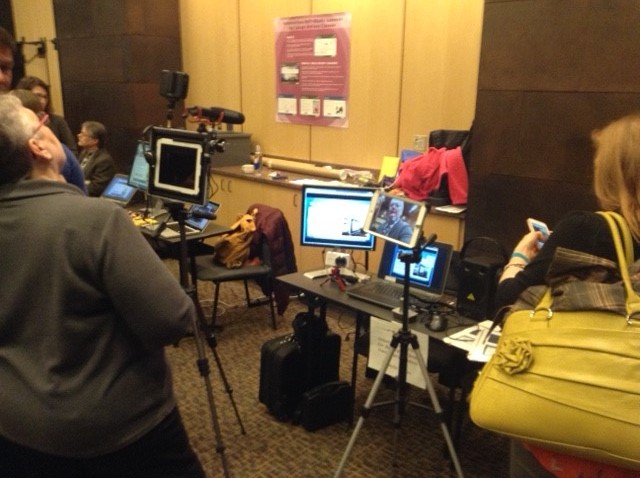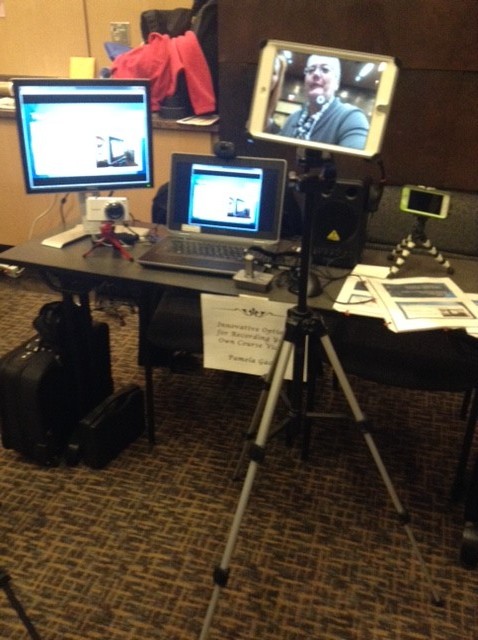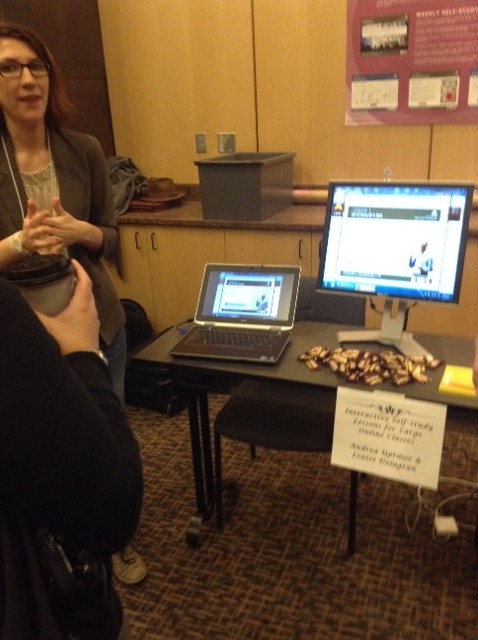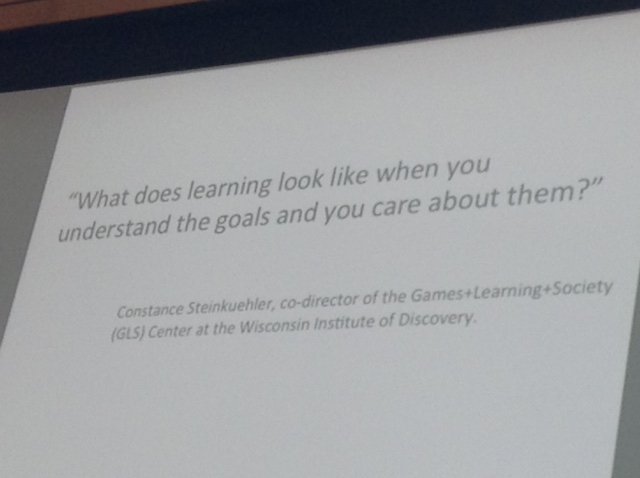Searching for "flipgrid"
My Note: synchronous vs asynchronous; Adobe Connect vs Zoom. Also Flipgrid for asynchronous videochats.
From: EDUCAUSE Listserv <BLEND-ONLINE@LISTSERV.EDUCAUSE.EDU> on behalf of Celine Greene <celine.greene@JHU.EDU>
Reply-To: EDUCAUSE Listserv <BLEND-ONLINE@LISTSERV.EDUCAUSE.EDU>
Date: Tuesday, April 23, 2019 at 2:38 PM
To: EDUCAUSE Listserv <BLEND-ONLINE@LISTSERV.EDUCAUSE.EDU>
Subject: [BLEND-ONLINE] Advice for Synchronous Online Classes Using Zoom Meetings?
Our school is transitioning from using Adobe Connect to using Zoom Meetings for synchronous online class sessions, of which most of our online courses schedule at least a few times each term. So after years of “controlling the user experience” with the Adobe Connect layouts and relying primarily on text chat, we are heading in the direction of screen sharing with the enhanced social and community-building experience of video “taking over” chat. Some people are very excited about this move, given the popularity and ease-of-use of the Zoom platforms. Other people are a little more wary – especially when it comes to large (e.g., 40 to 200+ students) classes.
Please share your thoughts and experiences on what faculty and students should be aware of when using Zoom Meetings (not the webinar) for a synchronous class session. Here’s some of the things I was curious about…
- Do you have a set of “instructions” or recommendations for students — e.g. so they see the chat as it happens?
- Are there any best practices in terms of meetings set-up that you recommend for your faculty? (Mute participants upon entry, always show meeting control bar, etc.)
- Have there been some scenarios that have been fantastic or some that have been horrible for using Zoom?
- Is there a class size where the number of participants starts negatively impacting the learning opportunity? (i.e., I realize Breakout rooms are an option but also not appropriate for all situations, such as having a guest speaker come in to have an interactive Q & A or having a software demonstration.)
- Are there any major “fails” you’ve learned from or, alternately, success stories?
- Are your students required to have Zoom accounts?
- Do you have a method for tracking attendance?
- …
Thanks for your input! – celine Celine Greene Instructional Technologist Center for Teaching and Learning, JHSPH http://ctl.jhsph.edu
+++++++++
more on synchronous learning environments
https://blog.stcloudstate.edu/ims?s=synchronous
https://twitter.com/search?q=%23ARVRinEDU&src=typd
Microsoft Takes a Bite Out of BrightBytes, Acquiring Its DataSense Platform and Team
Tony Wan Feb 5, 2019
https://www.edsurge.com/news/2019-02-04-microsoft-takes-a-bite-out-of-brightbytes-acquires-its-datasense-platform-and-team
From launching new tablets to virtual-reality curriculum, Microsoft has added plenty to its educational offerings
DataSense, a data management platform developed by Brightbytes.
DataSense is a set of professional services that work with K-12 districts to collect data from different data systems, translate them into unified formats and aggregate that information into a unified dashboard for reporting purposes.
DataSense traces its origins to Authentica Solutions, an education data management company founded in 2013.
A month later, BrightBytes acquired Authentica. The deal was hailed as a “major milestone in the industry” and appeared to be a complement to BrightBytes’ flagship offering, Clarity, a suite of data analytics tools that help educators understand the impact of technology spending and usage on student outcomes.
Of the “Big Five” technology giants, Microsoft has become the most acqui-hungry as of late in the learning and training space. In recent years it purchased several consumer brand names whose services reach into education, including LinkedIn (which owns Lynda.com, now a part of the LinkedIn Learning suite), Minecraft (which has been adapted for use in the classroom) and Github (which released an education bundle).
Last year, Microsoft also acquired a couple of smaller education tools, including Flipgrid, a video-discussion platform popular among teachers, and Chalkup, whose services have been rolled into Microsoft Teams, its competitor to Slack.
6 ways to use students’ smartphones for learning
By Kelsey Ehnle 12/26/2018 BYOD Mobile learning Tools
Smartphones also provide an easy way for teachers to “inspire students to positively contribute to and responsibly participate in the digital world,” as espoused by the
ISTE Standards for Educators.
research shows that when students are engaged in their learning — and they’re almost always engaged with their phones when given a choice — they are less likely to succumb to distractions.
1. Create short videos.
Videos can express any type of learning in any style, from music videos to interviews, book trailers, historical re-enactments, tutorials and stop animations.
Flipgrid is the one of the best educational video-creation sites
2. Access an online dictionary and thesaurus.
Find synonyms in many languages at Open Thesaurus!
Linguee.
PONS or LEO. Question about a verb conjugation? Go to LEO or Canoo (for German)
3. Collaborate and share with Padlet and Twitter.
4. Scan QR codes.
5. Listen to podcasts and read the news.
6. Compete against classmates!
Quizlet and Kahoot, Gimkit
https://blog.stcloudstate.edu/ims?s=kahoot
6. Use the apps, obviously.
++++++++++++++++
Gartner predicts that nearly 38 percent of companies will stop providing devices to workers by 2017 — but 20 percent of those BYOD programs will fail because of overly restrictive mobile device management measures. So how can IT pros devise a BYOD strategy that stays afloat? Here are six guidelines to accommodate legitimate IT concerns without sinking a policy’s odds of success:
Look to Existing Policies
Before creating a BYOD policy, take a look at existing HR and legal procedures. Many email, VPN, and remote access security policies can be applied to mobile devices, as well.
Provide Training and Education
Employees are using personal devices at work, whether the company realizes it or not. But that doesn’t mean they are using them correctly. Employees often use file-sharing and other tools of their choosing without IT’s knowledge, which could put sensitive corporate data at risk. Use a BYOD policy to trainemployees how to correctly use their applications
Specify Devices
BYOD isn’t limited to smartphones. According to Gartner, a “new norm” is emerging in which employees manage up to four or five devices at work.
Enforce Passwords and Encryption
passwords aren’t foolprool. Data encryption is an additional security measure
A smart BYOD policy doesn’t mean IT is off the hook. Rather, successful policies rely on IT and employees sharing security obligations.
Set Ownership Expectations
Employees often fail to realize that all data on their devices is discoverable, regardless of whether the device is personal or company-owned. The question of who owns what is still a legal gray area, though companies increasingly take the liberty to remote wipe employees’ personal devices once they leave their job. Avoid the guessing game with a clear exit strategy.
+++++++++++++++
more on BYOD in this IMS blog
https://blog.stcloudstate.edu/ims?s=byod
https://blog.stcloudstate.edu/ims?s=mobile+learning

please consider the following opportunities:
- Remote attendance through : https://webmeeting.minnstate.edu/collaborate
- Recording of the session: (URL will be shared after the session)
- Request a follow up meeting for your individual project: https://doodle.com/digitalliteracy
+++++++++++++
more on digital assessment in this IMS blog
https://blog.stcloudstate.edu/ims?s=edpuzzle
Unlocking the Promise of Digital Assessment
By Stacey Newbern Dammann, EdD, and Josh DeSantis October 30, 2017
https://www.facultyfocus.com/articles/teaching-with-technology-articles/unlocking-promise-digital-assessment/
The proliferation of mobile devices and the adoption of learning applications in higher education simplifies formative assessment. Professors can, for example, quickly create a multi-modal performance that requires students to write, draw, read, and watch video within the same assessment. Other tools allow for automatic grade responses, question-embedded documents, and video-based discussion.
- Multi-Modal Assessments – create multiple-choice and open-ended items that are distributed digitally and assessed automatically. Student responses can be viewed instantaneously and downloaded to a spreadsheet for later use.
- (socrative.com) and
- Poll Everywhere (http://www.pollev.com).
- Formative (http://www.goformative.com) allows professors to upload charts or graphic organizers that students can draw on with a stylus. Formative also allows professors to upload document “worksheets” which can then be augmented with multiple-choice and open-ended questions.
- Nearpod (http://www.nearpod.com) allows professors to upload their digital presentations and create digital quizzes to accompany them. Nearpod also allows professors to share three-dimensional field trips and models to help communicate ideas.
- Video-Based Assessments – Question-embedded videos are an outstanding way to improve student engagement in blended or flipped instructional contexts. Using these tools allows professors to identify if the videos they use or create are being viewed by students.
- EdPuzzle (edpuzzle.com) and
- Playposit (http://www.playposit.com) are two leaders in this application category. A second type of video-based assessment allows professors to sustain discussion-board like conversation with brief videos.
- Flipgrid (http://www.flipgrid.com), for example, allows professors to posit a video question to which students may respond with their own video responses.
- Quizzing Assessments – ools that utilize close-ended questions that provide a quick check of student understanding are also available.
Integration of technology is aligned to sound formative assessment design. Formative assessment is most valuable when it addresses student understanding, progress toward competencies or standards, and indicates concepts that need further attention for mastery. Additionally, formative assessment provides the instructor with valuable information on gaps in their students’ learning which can imply instructional changes or additional coverage of key concepts. The use of tech tools can make the creation, administration, and grading of formative assessment more efficient and can enhance reliability of assessments when used consistently in the classroom. Selecting one that effectively addresses your assessment needs and enhances your teaching style is critical.
+++++++++++++++++
more on digital assessment in this IMS blog
https://blog.stcloudstate.edu/ims/2017/03/15/fake-news-bib/
Academy of distinguished teachers, Innovation
University of Minnesota, McNamara Alumni Center – Twin Cities Campus. April 8, 2015
Full program available here: https://guidebook.com/g/adt/

Randy Bass
Randy Bass
https://www.linkedin.com/pub/randall-bass/14/94/77
flipping disruption into Design
there are two type of universities: the ones that are in control of change and the ones, which are pressed to change.
what kind of education is needed at this moment of history.
Assumptions: 5-10 years will be for a first time outcompeted in terms of delivering information and degrees. What is that the university can do distinctively well that WWW cannot do: mentored learning and the arc of learning (beyond collection of granular separate learning)
book: The New Division of Labor. http://www.amazon.com/The-New-Division-Labor-Computers/dp/0691124027
External forces of potential disruption: 1. MOOCs, nearly free education, 2. skilled-based learning (Codeacademy, Udacity), 3. data analytic 4. public pressure on access, metrics of impact.
Gartner group (http://www.gartner.com/technology/home.jsp) hype cycle : overvalued in a short term and undervalued in a long term. MOOC is excellent example.
NMC: competing models of education.
learning analytics. adaptive learning, intelligent tutoring etc. Open Learning Initative. http://oli.cmu.edu/
In the 19th century, railroads companies which were in the business of railroad companies went under; the ones which were in the business of transportation survived. Parallel, universities, which are in the business of delivering information will die out; the ones, which will survive must look to a very different picture.

formative wider outcomes
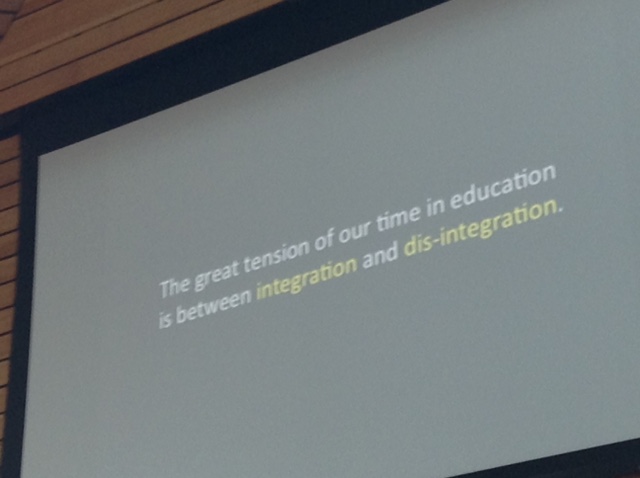
integration and dis-integration
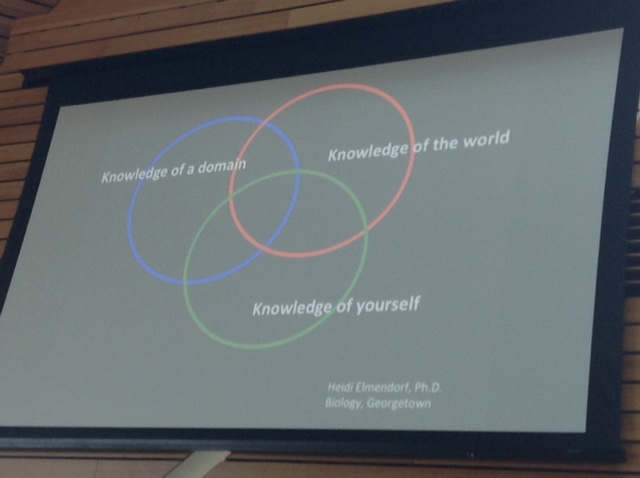
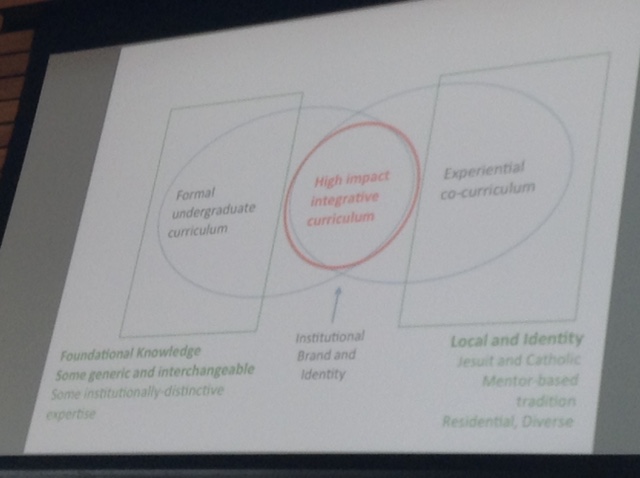
high impact integrative curriculum

what makes high inpact practices high impact
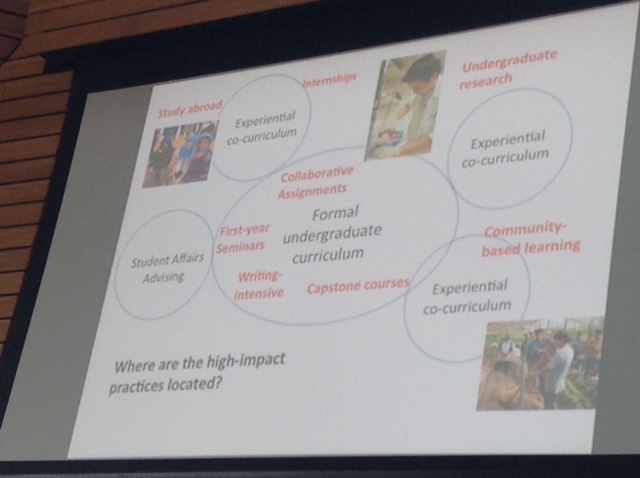
formal versus informal
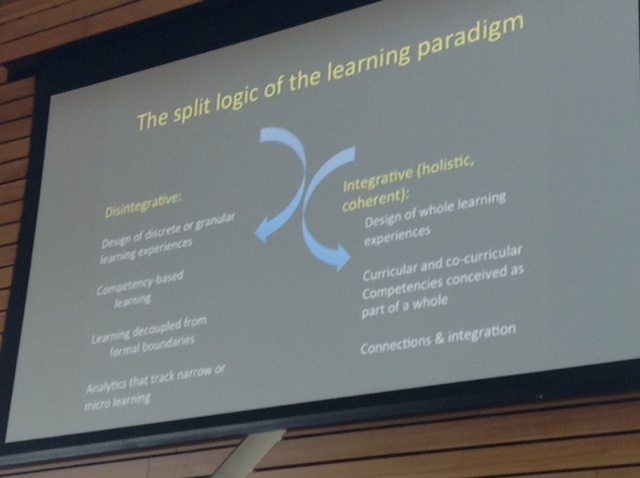
Selected sessions:
The Value of Assessing Outcomes of Teaching Methodologies to guide instructional design
https://guidebook.com/guide/33541/event/10594685/
game-based learning:
Upping your Game – Best Practices in Using Game-Based Learning
https://guidebook.com/guide/33541/event/10594684/
Implementing Game Dynamics in Moodle
https://guidebook.com/guide/33541/event/10693434/
visuals:
Engaging Students through Video Integration
https://guidebook.com/guide/33541/event/10676389/
https://guidebook.com/guide/33541/event/10676375/
Using Flipgrid Video Commentary to Share Student Learning
https://guidebook.com/guide/33541/event/10676361/
————
Enhancing learning with online narrated presentations using VoiceThread
https://guidebook.com/guide/33541/event/10676372/
flipped:
Essential Technology & Tools for Flipping Your Classroom
https://guidebook.com/guide/33541/event/10676385/
Improving Delivery of Technical Course Content through Incremental Use of Classroom “Flipping”
https://guidebook.com/guide/33541/event/10676376/
https://guidebook.com/guide/33541/event/10594850/
The Pros and Cons of Flipping the Classroom
https://guidebook.com/guide/33541/event/10676323/
Using Google Forms for Student Group Evaluations
https://guidebook.com/guide/33541/event/10734863/
Library:
The University Libraries Partnership for Affordable Content – Enhance Student Learning and Save Them Money!
https://guidebook.com/guide/33541/event/10676358/
CRS Tophat:
Using Classroom Debates as an Interactive Learning Tool in a Course on Companion Animal Ethical Issues
https://guidebook.com/guide/33541/event/10676369/
online:
Adapting the Harvard Case Method for Online Courses
https://guidebook.com/guide/33541/event/10595018/
Readiness Assessment for Online Courses
https://guidebook.com/guide/33541/event/10595040/

technology showcase general view
